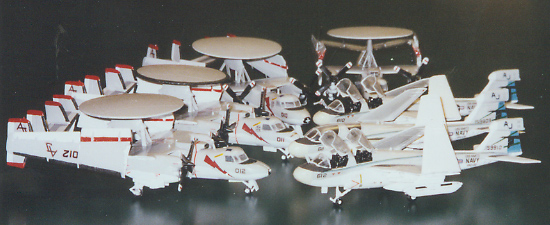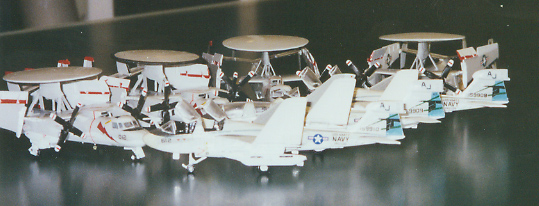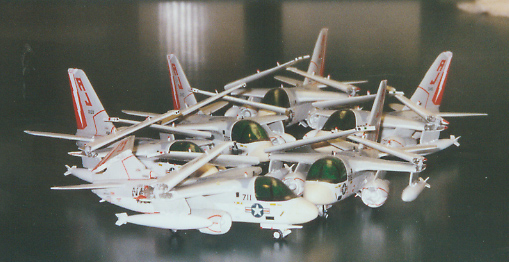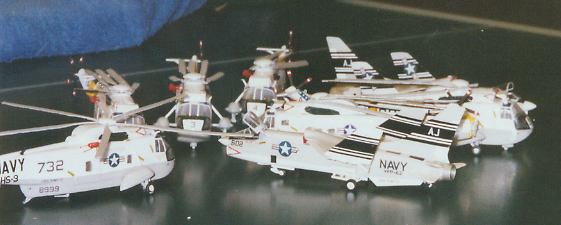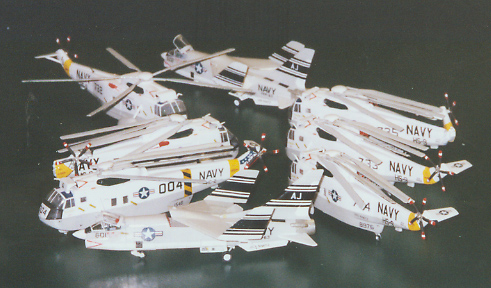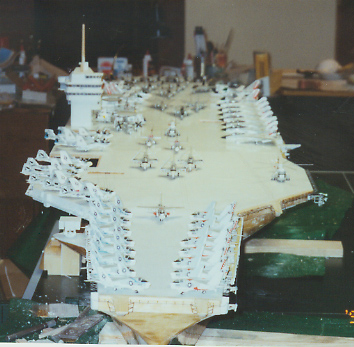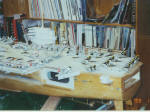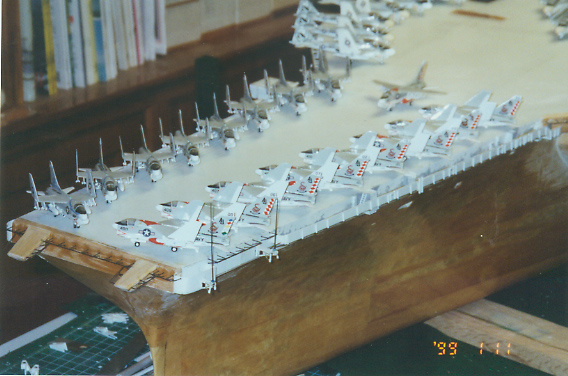|
Building a 1:144
Scale Radio-Controlled USS Nimitz:
The When I began to think about building a 1:144 Nimitz, no kits in this scale existed beyonda few fighter and attack aircraft. Luckily in a sense, the build has taken so long (several address changes, seven years with two jobs, three years to build the rec room/work area/display area in the basement) that now most aircraft types for CVW-8 are covered -- I have only had a few aircraft to scratchbuild.
The first and second pictures show three EA-6B's of VAQ-135 'Black Ravens' and four E-2C's, three from VAW-124 'Bear Aces' and one machine from VAW-112. I will not make any more EA-6B's but I might make another E-2C of VAW-112 'Golden Eagles'. The EA-6B Prowlers are Dragon kits, and one of the best they produced. None have crews but two of the three have the canopies popped. The interior detail provided is quite good and adequate for my purposes but dedicated super-detailers (like 'neu' with his 1:144 F-18) will want to add more --drop the flaps, pull down steps, FOD covers, and so on. And come close to creating beauties such as Jan Visser's Prowler found on this website. The E-2C's are from Revell of Germany and are a recent release (September 2004). These are excellent kits and have only two weaknesses. First, the engraving is too heavy, particularly on the radome; and secondly, the wheel wells are not enclosed. The planes need a nose weight because they are tail-heavy but because the plastic they are made from is soft, cutting out of wings and flaps is relatively easy.
Picture three shows six S-3B's. Interestingly, I was resigned to scratchbuilding these aircraft (picture four) and had them more than half-completed when Yuuichi Kurakami of YK Craft produced a 1:144 resin kit of the S-3 (picture 5). These are very good, have excellent detail, requiring only filler at the wing roots and a few deep panel lines on the fuselage. He was also kind enough to supply me with decals (picture 6) for CVW-8. His website should be updated by the time you read this www.alpha-net.ne.jp/users2/kura1/mswtopENGLISH.htm. Of the S-3's shown in picture three, two are resins from Yuuichi and the other four are basswood scratchbuilds: all the fuel tanks are basswood and an attempt has been made to detail the wing-fold and tail-fold mechanisms. I don't have a good digital camera so highly-detailed close-ups are, regretably, not possible.
Pictures seven and eight show six SH-3's and two RF-8G's. All these aircraft are resin, the product of a Czech master molder named Radek Skoumal. He and his partner, Eric Faustus, created FEResins (www.fe-resin.net) and what they produce is excellent. Eric produces the 1:72 subjects and Radek produces the 1:144 kits. Most of the 1:72 aircraft are WWII while a large number of the 144 offerings are aircraft of the Vietnam war. For the SH-3's, five are in the markings of HS-9 'Dragonslayers' and one ('004' on picture 7) is from HC-2. Two have the tail rotors folded back. The two RF-8G's are from VFP-63 'Eyes of the Fleet'.
Pictures 9 to 13 show 65 aircraft on the unfinished model. I am getting anxious to complete this project (November 2005 is my goal). Altogether, I have made 77 aircraft for CVW-8 but not all can be displayed at the same time. For example, RA-5C Vigilantes were never on the flight deck at the same time as RF-8G Crusaders. Here the 'Go Navy' website www.ne.jp/asahi/gonavy/atsugi/ is invaluable for all USN carrier modelers. For any given display, I anticipate a maximum of 58 to 66 aircraft on the flight deck, and only two or three in the hangar deck There is two aircraft types missing -- a C-2 which I hope to have done this year, and a Skywarrior which I will not be doing for this ship. DISPLAY CONSIDERATIONS: all the modelers who are register on this website, and those who visit it, should be familiar with the 'unofficial US Navy website' -- www.navysite.de or http://united-states-navy.com/ Go to the site map, click on 'Ships', then 'carriers' and then 'click here to read more about carriers'. Here you will find a one page article on how aircraft are normally parked on the deck on modern American aircraft carriers. This information is very useful, particularly for those many modelers who have built or are building any American super-carriers from Forrestal (CV-59) to Bush (CVN-77). Since all USN supercarriers have 4 catapults and 4 elevators, their 'deck-spotting' patterns will be similar (CVN-78 with only three proposed elevators may change these patterns). It would be an interesting task for modelers on this website to find if there were regular patterns of 'deck-spotting' for other USN carrier classes in different eras (1927-41; WWII; Korea: SCB-27C's in Vietnam; the Midways in different eras) and deck-spotting for carriers of other nations. British and IJN in WWII, modern light carriers (e.g. Invincibles, Giuseppe Garibaldi), the large USN Tarawa and Wasp class amphibians -- all these would be helpful for modelers. Pictures of the modern French carrier Charles de Gaulle appear to show a 'deck-edge spread' for the airwing, although I have yet to see a picture of more than 21 aircraft/helos on the flight deck at any one time (even though capacity is listed as 40). Food for thought and discussion. Perhaps members who personally know servicemen and women aboard these ships might be able to contribute information for the 'real carriers' section of this website.
End of Part III. Photos and text © 2005 by Dan Linton May 4, 2005 |
